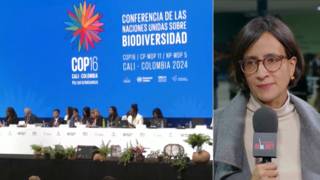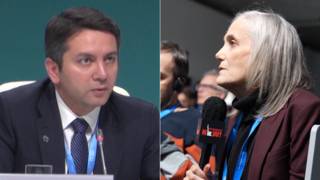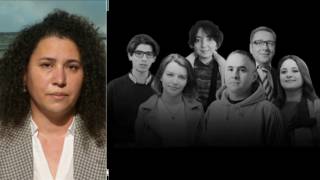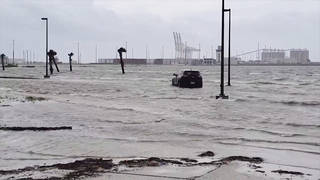
Related
Topics
As the toxicity of the New Orleans’ floodwaters grows worse, we look at the environmental and public health dangers looming in the city. We speak with a chemical toxicologist and independent water-consultant about the problems brewing in the water of New Orleans. [includes rush transcript]
Well the death toll from hurricane Katrina’s devastation continues to mount. While there is still no official count, public authorities have estimated the numbers of those killed could be as many as 10,000. Adding to the danger and tragedy in New Orleans is the growing toxicity of the stagnant floodwaters laced with chemicals, dead bodies, oil and human waste. On Wednesday the Environmental Protection Agency announced the first results of floodwater samples show high levels of E. coli and lead. EPA Administrator Stephen Johnson told reporters that in all cases amounts exceeded 10 times the safe limit and issued a warning against making contact with the floodwaters.
As many as five people have died so far from contaminated floodwater, the U.S. Centers for Disease Control and Prevention said on Wednesday. Officials suspect they contracted infections after coming into contact with cholera-related bacteria. Last weekend Democracy Now! producer John Hamilton was in New Orleans and asked a local resident and physician, Dr. Tuti Sheiban, if she thought the floodwaters around them were a health hazard.
- Dr. Tuti Sheiban, physician and local resident of New Orleans. “I think it is. In my medical opinion, yes. We have corpses here. We have corpses that have been here for a few days. We have human corpses, animal corpses. We have sewage. It is just sitting here. This is a different climate than what people know. It’s been over 100 degrees here every single day with this stagnant water. There are some fish in it. But it’s some dirty water. I think it’s going to be a serious health risk. Particularly West Nile. We have West Nile already in Louisiana before this happened. We haven’t had a whole lot of deaths, but we have had incidents of West Nile killing people and I think that this still water is where those mosquitoes breed. And now we have all these mosquitoes and all these people and all this dirty water. I think it is pestilence waiting to happen. I’m very concerned about this water and these conditions, for the people that we do save.
New Orleans began pumping the toxic floodwaters into Lake Pontchartrain on Monday. Michael McDaniel, the Louisiana secretary of environmental quality, said it was “simply unfeasible” to attempt to filter the water before flowing it into the lake. The EPA granted the Army Corps of Engineers a waiver from treating floodwater before sending it into Lake Pontchartrain. Also complicating the clean up, are two major oil leaks found in St.Bernard and Plaquemines parishes. Much of that oil has flowed into the Gulf of Mexico. Now people are asking questions about the environmental costs and whether the coastal waters will suffer long-term environmental damage. As the death toll continues to mount, how significant is the environmental toll?
- Harold Zeliger, a chemical toxicologist and water-quality consultant. He has investigated hundreds of toxic chemical exposures and environmental spills nationally and internationally.
Transcript
AMY GOODMAN: EPA Administrator Steven Johnson told reporters that in all cases, amounts are said to exceed ten times the safe limit and issued this warning:
STEVEN JOHNSON: Emergency response personnel and the public should avoid direct contact with any floodwater as much as possible.
AMY GOODMAN: As many as five people have died so far from contaminated flood water, according to the US Centers for Disease Control and Prevention. Officials suspect they contracted infections after coming in contact with cholera-related bacteria. Last weekend, Democracy Now! producer, John Hamilton, was in New Orleans and asked a local resident and physician, Dr. Tuti Sheiban, if she thought the floodwaters around them were a health hazard.
DR. TUTI SHEIBAN: I think it is, from my medical opinion, yes. I mean, we have corpses here. We have corpses that have been here for a few days. We have animal corpses, we have human corpses, we have sewage. It’s just sitting here. This is a different climate than what people know. It’s been over 100 degrees here every single day with this stagnant water. There are some fish in it, but it’s some dirty water. I think it’s going to be a serious health risk, particularly West Nile. We have West Nile already in Louisiana. Before this happened we haven’t had a whole lot of deaths, but we have had incidents of West Nile killing people, and I think that this still water is where those mosquitoes breed, and now we have got all these mosquitoes and all these people and all this dirty water, and I think it’s just pestilence waiting to happen. I’m very concerned about this water and these conditions, for the people that we do save.
AMY GOODMAN: That was Dr. Tuti Sheiban speaking to Democracy Now! producer John Hamilton in New Orleans last weekend as they rode in boats trying to save people. New Orleans began pumping the toxic floodwaters into Lake Pontchartrain Monday. Michael McDaniel, the Louisiana Secretary of Environmental Quality says it’s, quote, “simply unfeasible to attempt to filter the water before flowing it into the lake.” The EPA granted the Army Corps of Engineers a waiver from treating floodwater before sending it into Lake Pontchartrain. Also complicating the clean-up are two major oil leaks found in St. Bernard and Plaquemines parishes. Much of that oil has flowed into the Gulf of Mexico. Now people are asking questions about the environmental costs and whether the coastal waters will suffer long-term environmental damage as the death toll increases. How significant is this environmental toll? We’re joined on the phone by Harold Zeliger, a chemical toxicologist and water quality consultant. He’s investigated hundreds of toxic chemical exposures and environmental spills nationally and internationally. Welcome to Democracy Now!, Dr. Zeliger.
HAROLD ZELIGER: Thank you. Good to be here.
AMY GOODMAN: Can you just talk about what the water contains, the “toxic soup”?
HAROLD ZELIGER: Sure. You have mentioned, and others have mentioned, the biological components: the bacteria, the viruses, their spores —
AMY GOODMAN: Are you on a speakerphone? Doctor Zeliger, are you on a speakerphone?
HAROLD ZELIGER: Yes, I am
AMY GOODMAN: Could you come off the speakerphone? It will be clearer for us.
HAROLD ZELIGER: Let me do that.
AMY GOODMAN: Thank you.
HAROLD ZELIGER: Sure.
AMY GOODMAN: Okay. Go ahead.
HAROLD ZELIGER: How’s that?
AMY GOODMAN: That’s much better.
HAROLD ZELIGER: Okay, so we have the biological component, but — and you also mentioned the oil leaks and the — there’s a huge chemical component here. New Orleans area is surrounded by petrochemical refineries, by processing plants, by manufacturing facilities, and a good number of these have been breached during the storm and ooze their content into the water that’s now in New Orleans. I believe yesterday, EPA announced that the levels of lead in the water were extremely high. So, we have this enormous soup.
Now what does this soup do? First of all, the individual chemical components have their own toxic hazards associated with them, but my research and that of others, as well, has shown that when one has chemical mixtures, what can happen could be even much more severe and much different from the individual chemicals. Let me be a little specific, if I may. When mixtures are studied, what their effects are on health, sometimes you get as much as ten times or higher as severe a reaction as one would get to the individual chemicals.
Another area we run into is that the target organs are different. In other words, say we have chemicals that are known to attack certain parts of the body. The mixtures often attack parts of the body never envisioned from a consideration of just single chemicals. That is — we can study those and I have studied those, and I say others have also, when we can define the mixtures. In this case we can’t define the mixtures. There are probably an infinite number of mixtures possible in that soup that’s sitting in the city right now.
So, what, I think, one can expect is in addition to the bacterial borne diseases and viral diseases, we can probably expect mysterious diseases or mysterious syndromes cropping up. This has happened — this happened to some extent after 9/11 in the people who were exposed to air downwind from the World Trade Center. Some say, and I would agree, that Gulf War Syndrome is another manifestation of this. Still another would be Radiated Mail Syndrome. People who work with mail that’s been irradiated have symptoms that cannot be accounted for by testing the air that they breathe where they work. So I think one can probably expect to see some of this in New Orleans and unfortunately, it’s impossible to predict what form it will take.
AMY GOODMAN: Harold Zeliger, what about people who are staying there? First of all, health care workers, people who are cleaning out New Orleans and those who simply are afraid to leave because they saw what happened to people at the Convention Center?
HAROLD ZELIGER: My heart goes out to these people. They have lost everything. And they — I understand their fear, and certainly, I have not walked in their shoes, and I can’t really feel what they’re feeling but they are like survivors of major catastrophes who are just afraid to leave, and a lot of these people regretfully, are — have — don’t have a sophisticated education, and I think it’s incumbent upon the officials in the New Orleans area to coax them out, not drag them out. To the extent possible, try to educate these people to the risks. And try to show them that by staying there, they are really risking their lives. As far as the health care workers and the response people, they should, I think, wear masks on their faces at all times. They should be — if they’re walking through the water, should be wearing hip-waders so that they’re not — the skin is not exposed to this soup, because a lot of these chemicals will absorb through the skin right out of the water, even when the skin is not cut or scratched.
AMY GOODMAN: What about airborne disease?
HAROLD ZELIGER: Airborne is another consideration, and in fact, watching the images on television of the pumps pumping the water, just that pumping is generating an enormous amount of airborne contamination. The spray coming off it is contaminated with everything that’s in the water. And as the waters recede and as the city dries out, starts to dry out — again, we’re looking at months down the road — we’re going to get more and more airborne particulates and airborne chemicals from evaporation of those materials that vaporize, and when the solid materials are left behind, just the wind blowing will generate dusts, and these dust will be extremely toxic.
AMY GOODMAN: Harold Zeliger, I want to thank you very much for being with us, chemical toxicologist.












Media Options